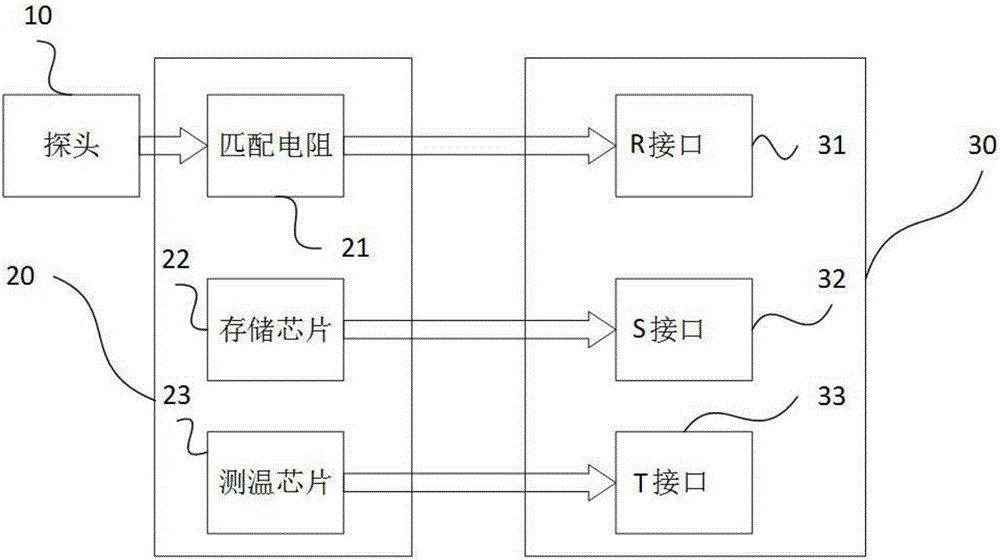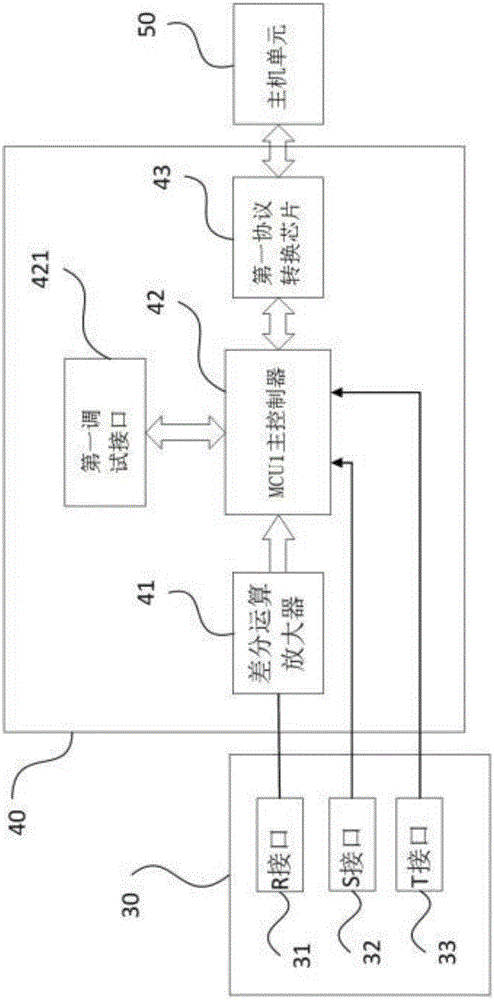Minimally-invasive intracranial pressure and intracranial temperature monitoring system and probe zeroing method
A monitoring system and internal temperature technology, applied in the field of medical devices, can solve the problems of affecting signal stability, cumbersome use process, low yield, etc., to achieve high measurement accuracy and stability, improve production efficiency and improve design solutions. Effect
- Summary
- Abstract
- Description
- Claims
- Application Information
AI Technical Summary
Problems solved by technology
Method used
Image
Examples
Embodiment 1
[0038] like Figure 1-6 A minimally invasive intracranial pressure and intracranial temperature monitoring system shown includes a probe 10, a zeroing module 20, an interface module 30, an amplifying AD module 40, a host unit 50 and a wireless repeater 60, and the probe 10 is connected to zeroing Module 20, the zeroing module 20 is connected to the interface module 30, the interface module 30 is connected to the amplifying AD module 40, the amplifying AD module 40 is connected to the host unit 50, and the host unit 50 is connected to the wireless repeater 60 through a 2.4G wireless communication network;
[0039] The zeroing module 20 includes a temperature measuring chip 23, a memory chip 22 and a bridge matching resistor 21, and the probe 10 is connected to the bridge matching resistor 21;
[0040] The interface module 30 includes a T interface 33, an S interface 32 and an R interface 31, the bridge matching resistor 21 is connected to the R interface 31, the memory chip 22 ...
Embodiment 2
[0049] like Figure 1-7 The difference between the minimally invasive intracranial pressure and intracranial temperature monitoring system shown in Embodiment 1 is that it also includes a drainage tube 10B0, one end of the drainage tube 10B0 is closed by a plug 10B2 to form a closed end, and the other end is a At the open end, the drainage tube 10B0 is provided with a probe cavity 10B1, a guide needle cavity 10B3 and a drainage cavity 10B4, and the end of the drainage cavity 10B4 protruding from the opening end of the drainage tube 10B0 is provided with an adapter 10B6, and the probe cavity The probe 10 is placed in 10B1, and an opening is set in the shell of the probe cavity 10B1 corresponding to the probe 10. The pressure sensor 13 extends out of the drainage tube 10B0 from the opening and is used to contact the brain tissue to obtain pressure. The guide needle cavity 10B3 is placed in the guide Needle.
Embodiment 3
[0051] A probe zeroing method of a minimally invasive intracranial pressure and intracranial temperature monitoring system is realized on the basis of a minimally invasive intracranial pressure and intracranial temperature monitoring system described in Embodiment 1 or Embodiment 2, It includes the following steps:
[0052] Step 1: Establish the test environment: first install the probe 10 on the pressure gauge, apply a fixed pressure value to the probe 10 through the pressure gauge, then adjust the ambient temperature of the probe 10 to 25 degrees room temperature; finally adjust the bridge matching resistance 21. The bridge matching resistor 21 sends the pressure signal collected by the probe 10 to the MCU1 main controller 42, and the MCU1 main controller 42 uses the pressure signal collected by the probe 10 in the test environment as the parameter of the probe 10, and Write the parameters of the probe 10 into the memory chip 22;
[0053] Step 2: Put the probe 10 into the p...
PUM
 Login to View More
Login to View More Abstract
Description
Claims
Application Information
 Login to View More
Login to View More - R&D
- Intellectual Property
- Life Sciences
- Materials
- Tech Scout
- Unparalleled Data Quality
- Higher Quality Content
- 60% Fewer Hallucinations
Browse by: Latest US Patents, China's latest patents, Technical Efficacy Thesaurus, Application Domain, Technology Topic, Popular Technical Reports.
© 2025 PatSnap. All rights reserved.Legal|Privacy policy|Modern Slavery Act Transparency Statement|Sitemap|About US| Contact US: help@patsnap.com



